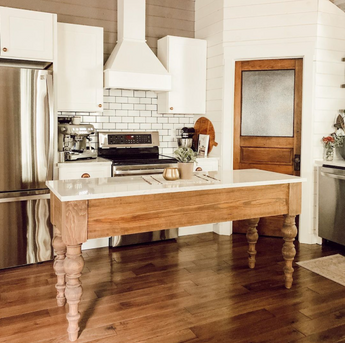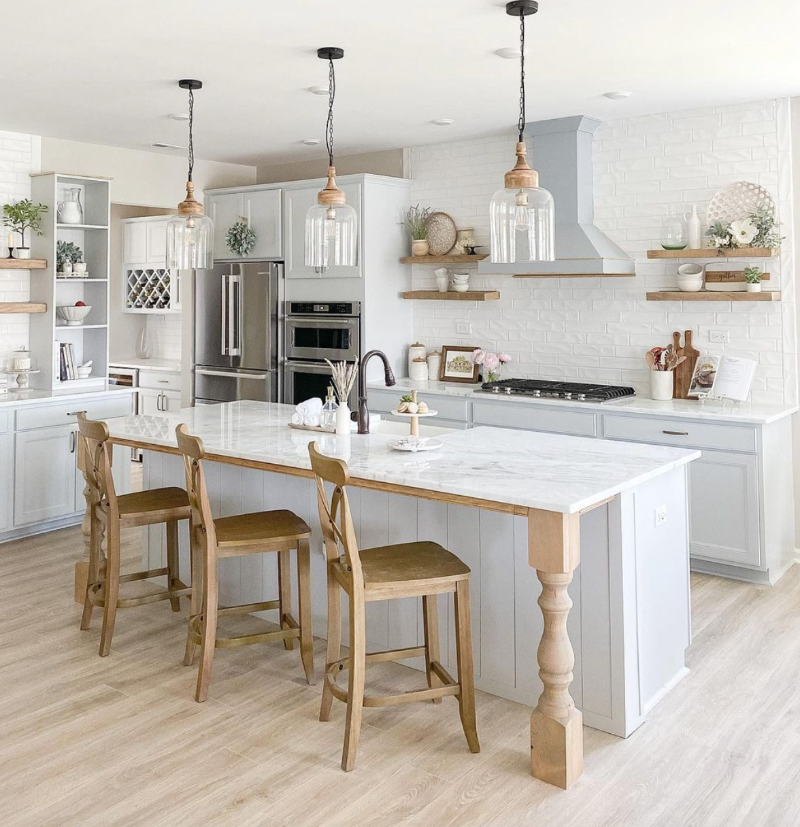A Comprehensive Guide to Selecting the Right Kitchen Island Leg
Checking Out the Vital Functions of a Kitchen Island Leg for Your Culinary Room
The cooking area island serves as a main hub in any type of cooking area, and the selection of leg design is crucial in enhancing both its capability and visual charm. Comprehending the crucial functions of cooking area island legs-- including material alternatives, design styles, and stability variables-- can considerably influence the total experience within the kitchen.
Value of Kitchen Island Legs
Kitchen area island legs play a critical role in both the performance and visual appeals of a kitchen area room. They not just support the weight of the island however additionally enhance the general layout, contributing to the kitchen area's aesthetic appeal. The option of legs can determine the style of the kitchen, be it contemporary, typical, or rustic.
Functionally, robust and appropriately made legs ensure security, enabling for the safe usage of the island for different tasks such as food prep work, eating, or enjoyable. Strong legs protect against tottering and changing, giving a dependable surface for daily activities.
Furthermore, the height and placement of the legs can influence the convenience degree for those seated at the island. A well-considered elevation can fit bar feceses or chairs, promoting a welcoming environment for gatherings.
In enhancement to these sensible factors to consider, cooking area island legs can work as a prime focus in the room (kitchen island leg). Decorative or uniquely made legs can boost the style aesthetic, making the island a centerpiece. Hence, picking the ideal kitchen island legs is important for balancing kind and function in any cooking room
Material Options for Legs
Selecting the ideal product for kitchen island legs significantly influences both toughness and style. Common product choices include metal, timber, and stone, each offering distinct benefits.
Wood is a preferred option due to its heat and flexibility. It can be conveniently personalized to match numerous decoration styles, from rustic to modern. Hardwoods like oak and maple supply outstanding toughness and durability, while softer timbers can be more susceptible to tear and wear.
Steel legs are favored for their smooth, modern-day aesthetic. kitchen island leg. Stainless-steel and aluminum are not only durable but additionally resistant to rust and deterioration, making them optimal for cooking area environments. They can develop a commercial look and are usually available in numerous coatings to complement various other cooking area elements
Stone legs, such as granite or marble, include a component of high-end and security. While larger than other materials, they use remarkable toughness and can withstand significant weight. They might call for additional support to guarantee appropriate equilibrium.
Ultimately, the selection of material need to line up with both functional needs and the general design vision of the cooking area space, making certain that the island legs improve both utility and aesthetics.
Style Styles to Take Into Consideration
What design styles should be taken into consideration when selecting legs for a cooking area island? The option of leg design substantially influences the general aesthetic of your culinary room. For a contemporary cooking area, minimalistic and streamlined leg styles, such as stainless-steel or geometric shapes, can improve the modern charm, offering a tidy and minimalist look.
On the other hand, typical kitchen areas take advantage of timeless designs such as transformed or carved wood legs, which include warmth and character. These alternatives frequently include intricate details that match classic furnishings. For a rustic atmosphere, take into consideration legs made from redeemed wood or wrought iron, which bring a natural, natural quality to the area.
If you lean in the direction of a commercial motif, robust metal legs with a distressed coating might be ideal, offering an edgy yet innovative touch. In addition, farmhouse style kitchens can integrate chunky legs that stimulate a feeling of toughness and homeliness.

Height and Stability Variables
The elevation and security of a kitchen island are essential aspects that directly impact its functionality and user experience. An optimal kitchen area island leg must give enough elevation to suit a selection of jobs, from food prep work to informal eating.
Security is similarly crucial, especially as kitchen area islands typically function as focal points in culinary environments. A stable leg design minimizes moving and wobbling, which can result in accidents or discomfort throughout usage. Materials such as solid wood, steel, or a mix thereof are typically employed to achieve the essential toughness. The leg's attachment to the island's base must be safe and secure, making sure longevity and resilience versus the wear and tear of everyday usage.
Personalization and Devices
Personalization alternatives and accessories for cooking area island legs can substantially enhance both the aesthetic allure and performance of the room. House owners can pick from a range of products, including timber, steel, and stone, permitting smooth assimilation with existing cooking area design. The selection of surface-- be it an all-natural discolor, repaint, or powder coating-- additional individualizes the look, making sure that the island complements the overall style motif.
In addition to material and surface, homeowners may likewise discover the unification of accessories such as ornamental braces, flexible feet, or incorporated shelving. Brackets can provide extra assistance while adding to a rustic or modern aesthetic. Adjustable feet are especially valuable for uneven flooring, guaranteeing the island stays steady and degree, which is critical for both safety and security and usability.

Conclusion
Finally, kitchen area island legs offer a vital function browse around this site in giving stability and enhancing the total visual of the cooking space. The choice of materials and style styles adds to both capability and visual appeal, while considerations of height and security make certain sensible use. Customization options and accessories can elevate the kitchen area island, making it an unique focal point within the home. Therefore, cautious consideration of these functions is necessary for a reliable cooking area layout.
The cooking area island offers as a central hub in any kind of cooking area, and the choice of leg design is crucial in boosting both its performance and visual appeal. Recognizing the crucial functions of kitchen area island legs-- including product choices, design styles, and security aspects-- can considerably impact the total experience within the kitchen area.Kitchen island legs play a critical function in both the functionality and aesthetic appeals of a kitchen room.What design styles should be considered when selecting legs for a kitchen island?In verdict, kitchen area island legs offer a vital role in supplying stability and boosting the overall visual of the culinary area.